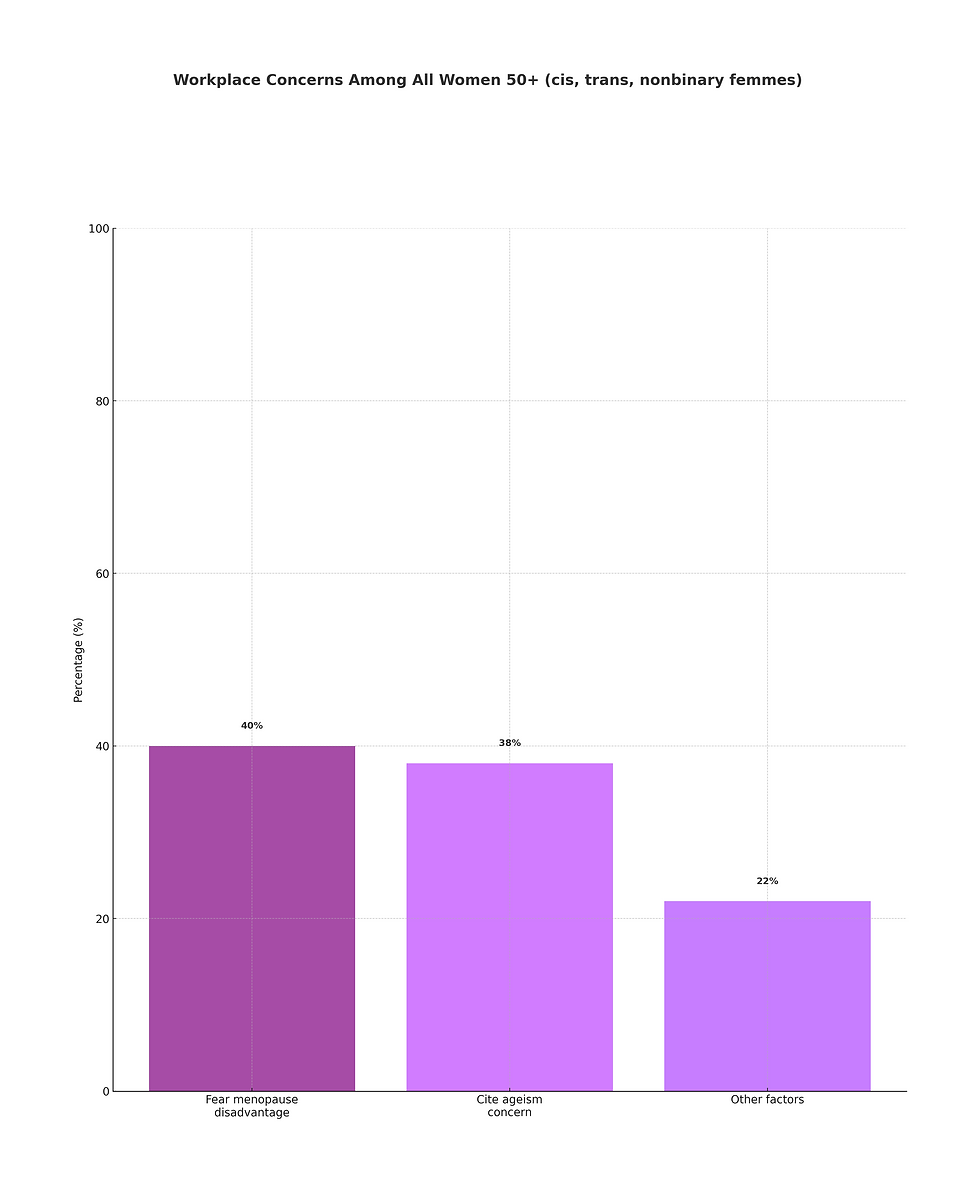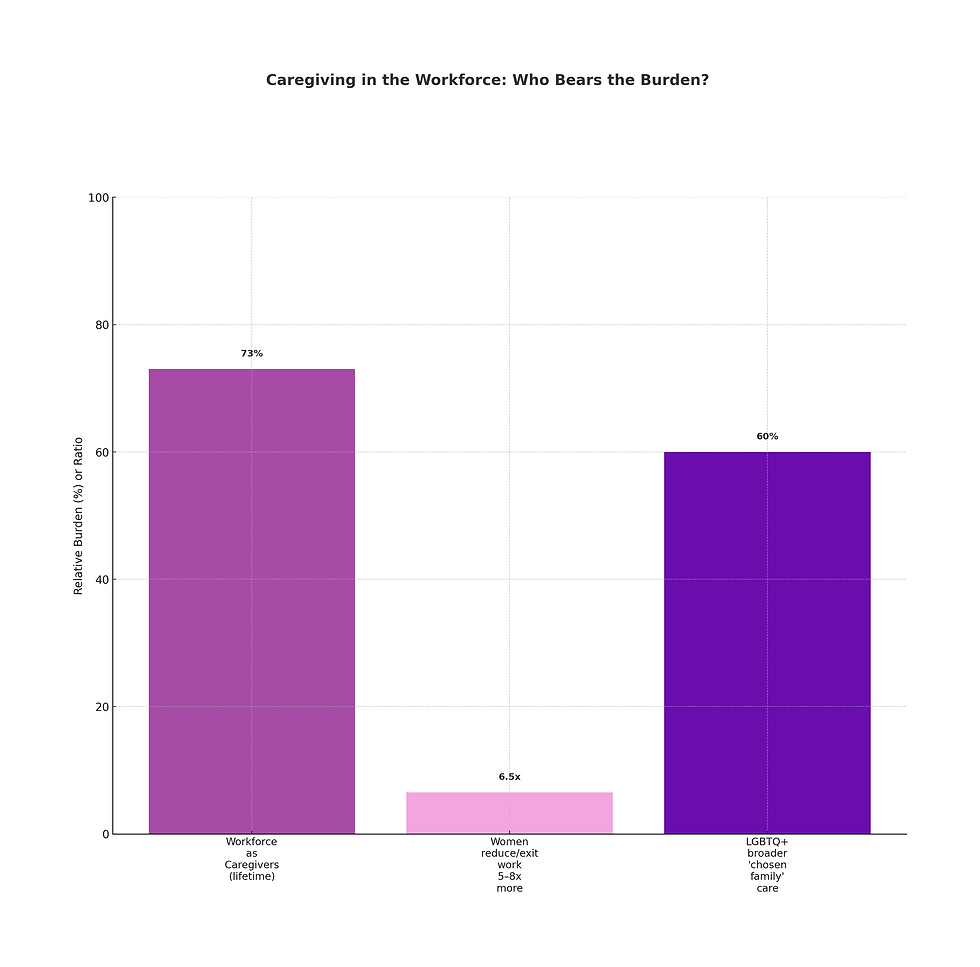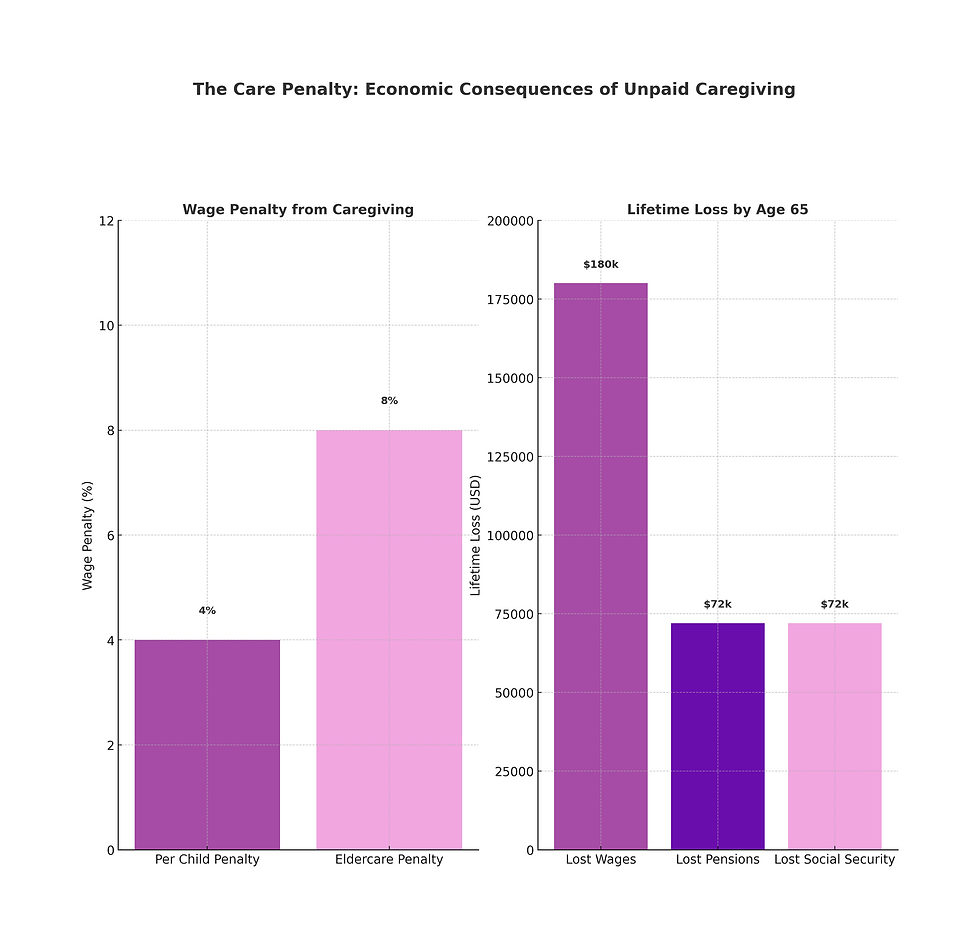Workplace Bias, Ageism, & Caregiver Pressures
- reenieb10
- Sep 8
- 6 min read
Updated: 3 days ago
By Carreen Schroeder
Part One: Ageism, Gender Bias & Caregiver Pressures
A Silent Struggle at Work
When Linda, 57, sat in a meeting fighting a hot flash while presenting to her team, she smiled through it—but later admitted: “I didn’t want to say anything. I thought it would make me look weak.”
When Alex, 51, a trans woman, interviewed for a mid-level leadership role, she worried less about the technical questions and more about whether her age and gender identity would mark her as “less employable.”
And when Jordan, 49, a nonbinary femme, requested flexible hours to care for their father with dementia, they were told their “commitment seemed questionable.”
These stories reflect what so many of us know: whether cis, trans, or nonbinary femme, women 50+ carry the weight of ageism, gender bias, and caregiving expectations in workplaces that rarely adapt to their realities.
Ageism & Menopause in the Workplace
Recent studies show the reality many women already know:
40% of women fear they’ll be disadvantaged at work because of menopause.
38% cite ageism as an ongoing concern.
Many feel uncomfortable discussing symptoms at all (New York Post, 2024).

Intersectional data deepens the picture:
Older Black and Latina women are more likely to be pushed into early retirement due to both racial and gender bias.
Trans women report unemployment rates twice the national average, with age compounding vulnerability.
Nonbinary employees are more likely to experience workplace erasure—where HR systems don’t even recognize their identities—contributing to feelings of invisibility.
For cis women, menopause can mean brain fog, disrupted sleep, and hot flashes. For trans men and nonbinary people who stop hormone therapy, similar symptoms can occur—but workplaces are even less prepared to recognize or accommodate them.
The bottom line? Age and hormonal health remain workplace taboos, leaving many employees to suffer in silence.
Barriers to Career Advancement
Systemic inequities don’t stop at biology—they extend to job opportunities.
Roughly one-third of older women work in low-wage jobs, often without benefits or retirement savings (Center for American Progress, 2023).
Older Black women: 40% earn low wages.
Older Latinas: over half (52%) earn low wages.
LGBTQ+ women over 50 are more likely to report workplace discrimination and less likely to have access to employer-sponsored retirement plans (Williams Institute, 2022).
This isn’t just the “glass ceiling.” It’s the gray ceiling, reinforced by gender, race, and identity bias.

Caregiver Discrimination
Cis, trans, and nonbinary femmes alike are still disproportionately cast into caregiving roles
Caregivers make up 73% of the U.S. workforce at some point, and women shoulder the majority (National Alliance for Caregiving, 2021).
Women are 5 to 8 times more likely than men to reduce work hours or exit the workforce to provide care.
LGBTQ+ caregivers are more likely to provide care for extended family or “chosen family,” which increases both hours of unpaid labor and financial strain.
Instead of being recognized as skilled multitaskers and community anchors, caregivers are often dismissed as “less committed.”

The Sandwich Generation: Caught in the Middle
Many women over 50 are part of the “sandwich generation”—simultaneously caring for aging parents and supporting adult or dependent children.
Nearly 1 in 4 middle-aged adults are supporting both an aging parent and a child.
Women spend 50% more time than men on unpaid caregiving.
Queer and trans women often extend this caregiving to chosen family, stretching already thin resources.

One subscriber shared: “I get up at 5 a.m. to check on my mother, go to work, then come home to help my daughter who moved back after college. I don’t have energy left for myself, let alone career advancement.”
This invisible labor drains not only individuals but also the broader workforce of seasoned, skilled talent.
Part Two: The Cost of Caregiving Bias — A Global Lens
The U.S. is not alone in its struggle to support women over 50 in the workplace. Around the world, caregiving expectations and workplace inequities combine to limit economic opportunity for all women.
Global Gender Gap & Workforce Participation
According to the World Economic Forum’s 2023 Global Gender Gap Report:
At the current pace, the global gender gap will take 131 years to close.
North America ranks high in education parity but has stalled in political empowerment and workforce equity.
Women worldwide make up 41.9% of the workforce, but representation dropped slightly after 2020, particularly in male-dominated industries.

For older women, the outlook is sharper:
In OECD countries, women 55+ have employment rates 15–20 points lower than men of the same age.
Globally, caregiving responsibilities are cited as the #1 reason women leave the workforce before retirement age.
The Care Penalty
The “care penalty” is a measurable economic consequence:
Women who provide unpaid care experience a 4% wage penalty per child and even greater penalties for elder care.
By age 65, caregiving-related career interruptions cost women an estimated $324,000 in lost wages, pensions, and Social Security benefits (AARP, 2022).
This penalty is magnified for women of color and LGBTQ+ femmes, who already face wage gaps and discrimination.

Right chart – Lifetime Loss💸 By age 65, caregiving-related career interruptions cost women an average of $324,000 in lost wages, pensions, and Social Security benefits. Women of color and LGBTQ+ femmes bear an even heavier burden.
Intersectional Realities
Black and Hispanic women in the U.S. are significantly more likely to work in service and care industries, which pay less and provide fewer benefits.
Trans women of color face some of the highest unemployment and underemployment rates, combining age, race, and gender identity discrimination.
In global contexts, women in lower-income nations often face triple jeopardy: unpaid care work, lack of labor protections, and systemic poverty.
Why This Matters
When all women—cis, trans, and nonbinary—are sidelined by ageism and caregiving bias, the consequences ripple outwards:
Families lose income and stability.
Companies lose seasoned leadership and institutional knowledge.
Societies lose billions in GDP from underutilized talent.
As the global population ages, solving these issues isn’t optional—it’s essential.
Final Thoughts
Workplaces were never designed with all women in mind. But they can be redesigned. By addressing ageism, menopause stigma, and caregiver bias—not just for cis women but also for trans and nonbinary femmes—we can create economies that reflect the full richness of women’s lives.
We can do better. We must do better.
📚 Citations & Sources
New York Post (2024). 40% of women fear workplace disadvantage due to menopause, 38% cite ageism as concern.👉 Read article
Center for American Progress (2023). Older women’s workforce challenges: low-wage jobs, limited advancement, and retirement insecurity.👉 Read report
National Alliance for Caregiving & AARP (2021). Caregiving in the U.S. — 73% of workforce are caregivers at some point; women 5–8x more likely to reduce work hours or exit.👉 Read full report
AARP (2022). Caregiving-related career interruptions cost women $324,000 in lost wages, pensions, and Social Security by age 65.👉 Fact sheet
Justice in Aging (2020). Older women are 80% more likely than men to live in poverty after 65.👉 Read resource
Alzheimer’s Association (2024). Two-thirds of Alzheimer’s cases are women.👉 Alzheimer’s Facts & Figures
World Economic Forum (2023). Global Gender Gap Report 2023 — gender gap will take 131 years to close; women are 41.9% of global workforce.👉 Read report
Williams Institute, UCLA (2022). LGBTQ+ older adults face higher rates of workplace discrimination and reduced access to employer benefits.👉 Read study
National Institute of Mental Health (2023). Depression rates nearly twice as high for women compared to men.👉 Depression Data
CDC (2024). Chronic conditions among adults over 50: 4 in 5 women live with at least one chronic condition.👉 CDC Data




I had a subscriber email me personally with the following questions and insights, so I wanted to share with my audience and then respond accordingly:
"I have a few questions I'd love answers to as well as a few comments:
What does "gender gap closure" mean? What's the target? 50/50? 90/10? I think a couple of words about the definition may be helpful because I don't know what the target is so I don't know what success looks like.
The same issue comes up again in the industry chart - healthcare is high, but oil is low... is that a problem? I don't want to work on an oil rig - as a woman OR as an older woman. Is…